Therefor the source of UHEs must be outside our galaxy, but closer than 30 million light years away, and very violently energetic.
Possible sources:
- Relativistic jets spewing from black holes.

Do the highest energy Cosmic Rays come from objects such as this? On the left is a radio telescope image of the active galaxy NGC-4261. The width of the image covers a region of space 88,000 light years across.Notice the bright orange jets that spray out above and below the centre. To the right is a close up image from the Hubble Space Telescope covering just 400 light years. It shows a doughnut shaped ring at the centre. This ring is thought to orbit a giant black hole with a mass more than a hundred million times that of our sun. From http://ast.leeds.ac.uk/haverah/origin.shtml
- Explosions of colliding neutron stars. Neutron stars are super-dense stars--so dense that the electrons have been stripped of of the atoms that make up the star, and only the nucleus of the atoms remain. When two of these super-dense stars collide, they may cause an explosion energetic enough to create UHEs.
- Collapsing topological defects in the fabric of space-time. This is tougher to explain, because it involves space-time, which is a way to explain gravity using a theory called general relativity. The basic idea is that the universe is made up of space-time, which can be thought of as a fabric. When the universe formed, there were knots, kinks and other defects in space-time. As the universe evloves and space-time smoothes out, these knots and kinks flatten out and release huge amounts of energy, which could accelerate particles as UHEs.